Church Historians Share Why You Should Care about Honoring Pioneers
Contributed By Rachel Sterzer, Church News staff writer
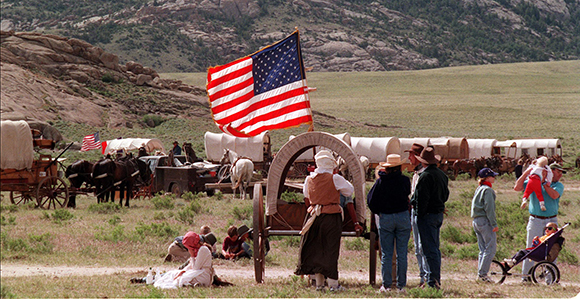
Handcarts and wagons set up camp at Independence Rock, Wyoming, during the 1997 sesquicentennial reenactment of the pioneers crossing the plains. Photo by Jeffrey D. Allred, Deseret News.
“The best way to honor our pioneer heritage is to learn about them. Not just the images in pageants or paintings, but the actual facts about their day-to-day experiences.” —Keith A. Erekson, Church History Library director
On the 150th anniversary year of the pioneers entering the Salt Lake Valley, President Dallin H. Oaks—like many Church members—participated in a modern reenactment of his pioneer forebears. In his October 1997 conference address, the then-Apostle recalled walking 13 miles on the wagon trails of 31 of his ancestors along the barren, craggy slopes of Rocky Ridge, Wyoming. Later he also traced five miles on the trail that three of his ancestors followed down El Cajon Pass to settle what is now San Bernardino, California.
After studying and reenacting the events of the past, it is appropriate to ask, “Therefore, what?” he said in his address. “Are these pioneer celebrations academic, merely increasing our fund of experiences and knowledge? Or will they have a profound impact on how we live our lives?” (“Following the Pioneers”).
Today, members around the world honor the Church’s pioneer heritage in songs, by sharing stories, or by reenacting early pioneer journeys. As Utah prepares to celebrate more than 170 years since the first pioneers arrived in the Salt Lake Valley, Church historians spoke with the Church News about why it’s important for Latter-day Saints to honor and remember their pioneer heritage.
Here's what they said:
“The experience of the Mormon pioneer vanguard company trek from Winter Quarters to the Salt Lake Valley in 1847, a distance of 1,100 miles in 111 days, is one of the most celebrated and epoch adventures in the history of the Church. Their journey changed the course of American history. During the decades that followed, tens of thousands of faithful Latter-day Saints from various parts of the U.S., Europe, and elsewhere gathered to Utah and the surrounding area, where they transformed the Intermountain region of the American West.
“Their pioneering effort was also prophesied by ancient and modern prophets. Isaiah foretold of the day when the house of Israel would be established in the ‘tops of the mountains’ (Isaiah 2:2–3); and in August 1842, Joseph Smith prophesied that the Saints would become ‘a mighty people in the midst of the Rocky Mountains’ (Joseph Smith—History, 1838–1856, volume D–1, p. 1362). The Mormon pioneers of yesteryear brought about and ensured the fulfillment of these prophecies.” —Alexander L. Baugh, department chair, Church History and Doctrine, Brigham Young University
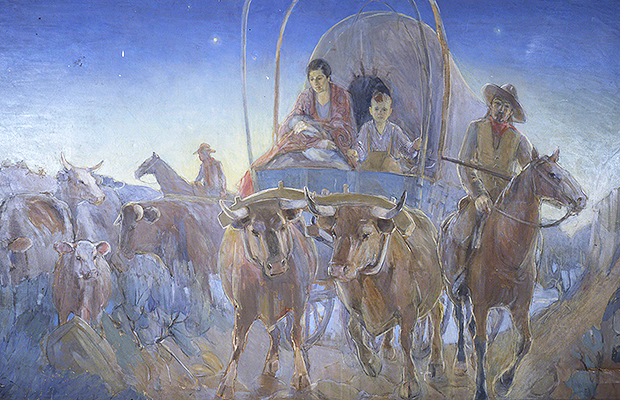
Covered Wagon Pioneers, Madonna at Dawn, by Minerva K. Teichert.
“Knowing about our pioneer heritage can give us, the spiritual descendants of pioneers, a powerful sense of rootedness and strength. Other people’s examples of courageous faith—from early converts in India to member missionaries in Russia to persevering souls in Ghana—build my faith and inspire me to live better. One of the best things we can do to honor our Latter-day Saint heritage is to look out for the needy among us and figure out how to help. Jesus taught us that when we serve a refugee, we are serving Him.” —Kate Holbrook, managing historian, Church History Department
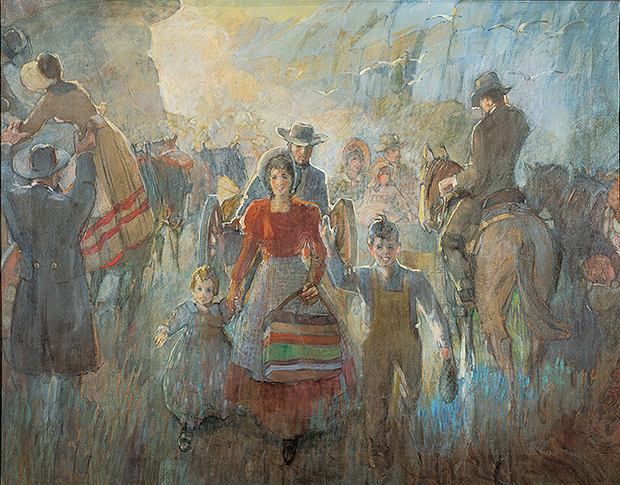
Pioneers Arriving, by Minerva K. Teichert.
“The best way to honor our pioneer heritage is to learn about them. Not just the images in pageants or paintings, but the actual facts about their day-to-day experiences. Sometimes this means we have to let go of cherished family stories, but the true stories we learn will be far more helpful in the long run.” —Keith A. Erekson, director, Church History Library
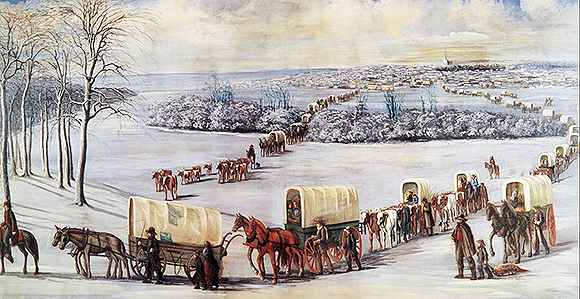
The Saints Crossing the Mississippi, by artist Grant Romney Clawson.
“Those that came before us sacrificed so much, leaving family and homelands to gather to Zion. With all the comforts we enjoy today, it is hard to imagine what they went through. We honor them by following their example of hard work and commitment to the Lord and His Church. When we encounter troubles and challenges, we can draw upon their faith and grit to see us through. There is great strength in studying the stories and devotion of our pioneer forebears. Irrespective of blood relations, Church members have a shared spiritual heritage that link us to not only the 19th-century pioneers that traveled overland to Utah, but also to modern-day pioneers throughout the worldwide Church.” —Brandon J. Metcalf, archivist/historian, Church History Department
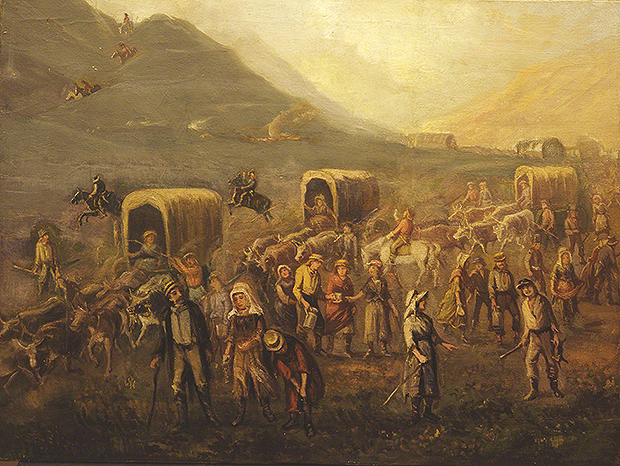
Mormon Emigrants Crossing the Plains in 1862, by Danquart Anthon Weggeland.
“When I learn about Latter-day Saints—pioneers from the 19th century and from across the globe—I realize we all have very real mortal challenges. Our heritage, whether that be those who crossed the plains, or those who were baptized in Africa or Russia, or of those keeping the flame of faith alive in an inner-city ward, reveals our identity as covenant people. Like me, they were not perfect, but like them, I can learn from their faith, sacrifice, testimony, and understanding of gospel doctrine. I too am a Latter-day Saint, and I too contribute to building the kingdom.” —Jenny Reader, historian, Church History Department
